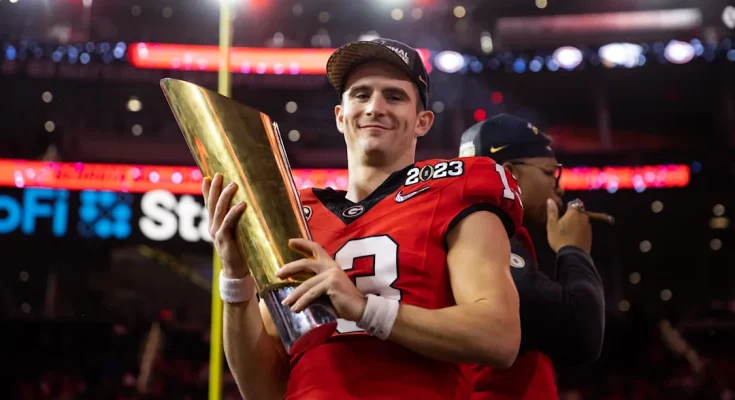Cam Newton’s jersey retirement has sent shockwaves through the college football world, particularly among fans and analysts of the Georgia Bulldogs, prompting a heated debate over the legacy of past quarterbacks and the expectations for the program’s future signal-callers. Newton, who led the Bulldogs to a national championship in 2010, is remembered not only for his prodigious talent but also for the transformative impact he had on Georgia football. His blend of size, athleticism, and arm strength made him a generational talent, capable of changing the trajectory of a program in a single season. His return to Athens to have his jersey retired was a moment steeped in nostalgia and reverence, yet it also reignited questions about the Bulldogs’ quarterback development pipeline and whether the program has produced, or will produce, a successor capable of living up to Newton’s towering standards.
The decision to retire Newton’s jersey is more than ceremonial; it is a declaration that his contributions are foundational to the Georgia Bulldogs’ modern identity. Fans and former players alike have celebrated the honor, noting that Newton’s impact went beyond statistics. His leadership style, ability to rally teammates, and knack for performing in high-pressure situations exemplified what it means to be a Bulldog. He was not merely a talented athlete; he was a cultural touchstone for the program. The ceremony itself drew attention from national media outlets and featured tributes from teammates, coaches, and even opponents, underscoring Newton’s influence both on and off the field. The event served as a stark reminder of the heights to which a quarterback can elevate the Georgia program, and it has naturally led to comparisons with subsequent Bulldogs quarterbacks.
Since Newton’s departure, Georgia has seen a rotating door of quarterbacks, some with flashes of brilliance and others whose careers have been marked by inconsistency. The contrast between Newton’s dominance and the performances of his successors has become a focal point for discussion. Critics argue that while Georgia remains a powerhouse in recruiting and overall talent, the program has struggled to cultivate a quarterback who can fully replicate Newton’s combination of athleticism, decision-making, and leadership. This ongoing discussion often centers around the question of whether Georgia prioritizes a certain type of quarterback, particularly those with mobility and dual-threat capabilities, or if the program seeks traditional pocket passers capable of executing high-level pro-style systems. Newton’s legacy, in this sense, has become a benchmark against which every incoming and current quarterback is measured, creating a heightened level of scrutiny that can affect both the players and the coaching staff.
The debate has also extended into the realm of recruiting strategy. Newton’s success at Georgia demonstrated that a dynamic, multi-faceted quarterback could thrive in the SEC, prompting high school quarterbacks with similar skill sets to consider Georgia as a landing spot. However, the program has faced challenges in consistently attracting elite quarterbacks capable of reaching Newton’s level, particularly given the national competition from programs like Alabama, LSU, and Florida. Each recruiting cycle brings speculation about whether the Bulldogs will secure a signal-caller who can match Newton’s physical tools while also demonstrating the leadership qualities necessary to command a high-pressure environment. Analysts have noted that the shadow of Newton looms large over every prospect, adding both prestige and pressure to the Georgia quarterback position.
Fans have contributed heavily to the debate, with social media serving as the primary battleground. Platforms such as Twitter and Instagram are filled with posts dissecting every throw, scramble, and decision of the current Bulldogs quarterback, with many comparisons drawn to Newton’s iconic plays. Highlights from Newton’s 2010 season circulate widely, serving as constant reminders of the standard set more than a decade ago. This phenomenon is not unique to Georgia; every program with a legendary quarterback experiences similar discussions. However, the fervor surrounding Newton is amplified by his continued presence in the football world, both through media appearances and his ongoing involvement in the NFL. His active career has kept his legacy in the spotlight, making the contrast with his successors more pronounced.
Coaching decisions also play a critical role in this discussion. Georgia’s coaching staff has been tasked with developing quarterbacks under intense scrutiny, balancing the need to win games immediately with the desire to nurture a long-term solution at the position. The legacy of Newton complicates this task, as coaches face pressure to find a player capable of embodying Newton’s unique blend of talent and charisma. Offensive schemes are often adapted to suit the quarterback on the roster, yet fans and analysts frequently debate whether the system is designed to maximize the player’s strengths or if it remains rigid in pursuit of a particular style reminiscent of Newton’s era. The conversation inevitably turns to the question of identity: should Georgia attempt to recreate the success of Newton, or should the program evolve to fit the modern trends of college football quarterback play?
The psychological aspect of this debate cannot be understated. Quarterbacks who follow in Newton’s footsteps are inevitably subjected to comparisons, sometimes unfairly, given the singular nature of Newton’s abilities. This can create a challenging environment for young players, as every decision on the field is analyzed through the lens of what Newton might have done. The pressure to live up to a legendary predecessor is immense, and the media’s focus on this narrative only heightens the intensity. Some players thrive under such pressure, using the comparisons as motivation, while others may struggle to establish their own identity within the program. The jersey retirement ceremony, while celebratory, acts as a symbolic reminder that the bar has been set exceptionally high.
Statistical analysis further fuels the debate. Newton’s numbers at Georgia, from touchdown-to-interception ratios to rushing yards and passing efficiency, are often cited in discussions about what defines an elite quarterback at the program. Modern analytics allow for deeper comparisons, breaking down quarterback performance in ways that were less common during Newton’s tenure. For example, advanced metrics such as Expected Points Added (EPA) per play or completion percentage over expected (CPOE) can illuminate how Newton’s decision-making and athleticism translated into tangible value on the field. When current quarterbacks are measured against these metrics, the discussion often reveals both the strengths and limitations of past and present players, providing a more nuanced view than purely anecdotal or highlight-based evaluations.
Cultural and institutional factors also influence the debate. Newton’s impact at Georgia extended beyond the Xs and Os; he became a symbol of the program’s resurgence and its ability to compete at the highest levels. His personality, media presence, and leadership qualities contributed to a larger narrative about what it means to be a Georgia Bulldog. This cultural imprint complicates the evaluation of future quarterbacks, as the discussion is not solely about athletic performance but also about intangible qualities like charisma, leadership, and the ability to inspire teammates. The retirement of his jersey reinforces this narrative, serving as a reminder that quarterback excellence encompasses more than statistics and game film—it embodies the spirit and identity of the program.
The debate surrounding Newton’s legacy also intersects with broader discussions about college football history and the SEC’s evolution. His success at Georgia occurred during a period when dual-threat quarterbacks were becoming increasingly prominent, challenging traditional notions of the position. In many ways, Newton helped redefine what an elite SEC quarterback could look like, paving the way for future athletes who blend passing prowess with mobility. As the SEC continues to attract top-tier talent, the question remains whether Georgia will produce another quarterback capable of influencing the game in a similarly transformative manner. Each recruiting cycle, game, and season adds new layers to the debate, reinforcing the ongoing relevance of Newton’s tenure.
Media coverage has amplified the conversation, with analysts, commentators, and former players weighing in on the implications of Newton’s jersey retirement. Some argue that the focus on legacy places undue pressure on current quarterbacks, while others contend that it provides a clear model of excellence to emulate. Debates range from tactical considerations—such as offensive scheme fit and decision-making under pressure—to broader questions about program identity, leadership, and cultural impact. In each case, Newton’s career serves as a touchstone, providing a lens through which fans and analysts interpret the present and future of Georgia football.
Ultimately, the retirement of Cam Newton’s jersey is more than a ceremonial gesture; it is a catalyst for reflection, discussion, and debate about the quarterback position at Georgia. It highlights the challenges of living up to a legendary predecessor, the pressures of national attention, and the ongoing quest to cultivate talent that can redefine a program. Newton’s influence on Georgia football is undeniable, shaping the narrative for past, present, and future quarterbacks. As the Bulldogs continue to recruit, develop, and compete, the conversation sparked by his jersey retirement will remain central to the discourse around the program’s identity and aspirations.
As new quarterbacks emerge, the debate will evolve, blending statistical comparisons, cultural impact, leadership assessments, and expectations for future success. Fans and analysts alike will continue to measure each player against Newton’s achievements, recognizing that his tenure at Georgia set a standard that is both inspiring and challenging. The conversation reflects not only on individual performance but also on the broader trajectory of the Bulldogs program, encompassing strategy, culture, recruitment, and historical context. Cam Newton’s jersey retirement, therefore, is far more than a personal honor—it is a symbolic event that reignites an enduring conversation about excellence, leadership, and the ever-present shadow of a legendary quarterback in the Georgia Bulldogs’ ongoing story.
The dialogue surrounding Newton and Georgia quarterbacks is unlikely to subside anytime soon. Each season brings new talent, fresh opportunities, and renewed comparisons, ensuring that Newton’s influence remains a benchmark for years to come. Fans, media, and players will continue to grapple with the question of what it means to follow in the footsteps of a generational talent, navigating the fine line between reverence for the past and excitement for the future. The retirement of his jersey is a permanent reminder of that legacy, an event that cements his place in Georgia’s history while simultaneously inspiring conversations about the program’s future. It is a moment that both honors the past and sets the stage for the ongoing evolution of Georgia Bulldogs football, reinforcing the idea that greatness, once achieved, becomes a standard against which all future players are measured.
Cam Newton’s jersey retirement, therefore, is not just a moment of celebration; it is a spark for reflection and debate, encapsulating the challenges, triumphs, and enduring legacy of one of the most influential quarterbacks in Georgia Bulldogs history. His impact is multifaceted, shaping not only the program’s past and present but also its future trajectory, and ensuring that the conversation about Georgia quarterbacks will remain dynamic, passionate, and deeply engaged for years to come.



